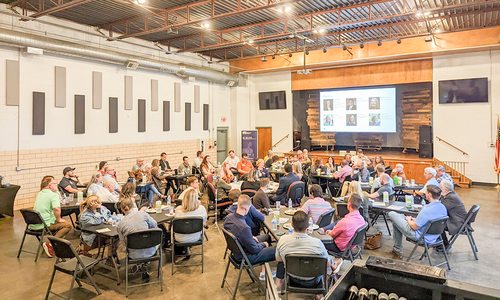
Strategy
Does my Business Need an App?
If you’ve dismissed phone apps because you thought they were too expensive, Dan Seawel and Darren Furr, co-founders of Sola Digital, are here to change your mind.
By Savannah Waszczuk | Photos courtesy Sola Digital
Sep 2017

Biz 417: What’s the starting price for an app?
Dan Seawel: We say a typical app starts at about $15,000 and will probably take about three months.
Darren Furr: That’s from start to finish, too. There’s a lot of discovery, requirements gathering and turning what’s in your head to a tangible design that we can then build off of.
Biz: Does every business need an app?
D.S.: The answer is no. You can find a justification to have an app, but at the end of the day, an app needs to perform a function. There is a unique way you can communicate through a phone alert, whereas if you just have a website and a blog, people aren’t going to remember to check it. If you can actually improve somebody’s life and save them time through an app, and the return on investment is there, which we will help you demonstrate, then yeah, it’s worth it.
D.F.: I think, too, what’s interesting is that once you really engage into that mind set of, “We can do an app. This is something we can do,” you realize there’s a whole additional way you can engage your client, because it’s active.
Biz: What defines a good app?
D.S.: I think the biggest thing is that you have to solve a problem. The problem could be as simple as, “I have too much free time, and I want to play a game.” But if you’re building an app because you think it’ll be cool to have an app as part of your digital portfolio, then it’s going to fail. Nobody is going to keep it on their phone.
D.F.: For me, what matters is if the component can scale. Instagram ran into that problem early on. When they launched Instagram in 2010 they had one server in a closet, and they launched it and got 100,000 users over the course of a week. They ended up having to basically rewrite a huge part of the product because it couldn’t scale. You want to be able to handle that. You want to be able to go the distance and not have to rewrite.
D.S.: Also, as far as design, it has to be engaging. It has to be a good experience, and something a user wants to open again.
Biz: What’s your insight on the business app trend?
D.S.: People don’t have separate devices anymore, because you can do everything with your phone. It used to be, ‘Well, okay, I’m okay with having a lesser camera because it’s on my phone and more convenient.’ No, now the camera is better. The video is better. You can store things in the cloud. GPS. Who has a physical device for GPS anymore? Also, consider that phones are the only devices that many people have. If you want to get your message out, whatever that is, it’s going to have to be on your phone. So, whereas if I would have said in the past, if all that you’re doing is telling a story, just put it on a website. Well, people aren’t checking your website. They can from your phone, but they’re not going to.
D.F.: I think, honestly, over the next five years—the fact that we’re driving down the cost of app development, not just for businesses but for not-for-profits—that’s opening up a new market segment and advertising segment that otherwise people have kind of dismissed. I think that over the next three to five years we’re going to see a lot more business apps starting to pop up in the app store. First, apps were very much about function. I think now, as Dan pointed out, it’s going to be more about engagement. Engagement around your business or your brand. Then, I think out further, 10 years, I think we’re going to start seeing a lot more engagement where we’re going to be talking to our devices rather than interacting with them physically.
Biz: As a business owner, how do you know if you need an app?
D.S.: You’ll get feedback. People will tell you, ‘You need an app. I’m tired of going to your website,’ or, ‘Man, if I knew what was on your menu.’ Something along those lines.
D.F.: An established business might be asking, ‘Is there a market segment that I’m missing?’ Your demographic may be older, but you’re trying to get into a younger demographic and make yourself more relatable to them.
Biz: What are benefits of apps over other forms of internet media?
D.S.: They can offer practical differentiators like real-time analysis. Someone who does it great—though I’m not necessarily a fan of their food—is Domino’s Pizza. They have an incredible tracking tool. I give my phone to my kids, and they watch the pizza. They see that Claire, the driver, is going to come in two minutes because she’s on the way. It’s really engaging, and they’ve done it well. I’m seeing more and more of those things. Now, Amazon will send you notifications of where your packages are. Jimmy John’s is another one. I think even local companies can start thinking through what it can be like to continually inform and having an engaging experience on a mobile platform.
Biz: Do you think businesses should charge for their apps?
D.S.: I suggest that people don’t charge unless they have to. There has to be some other way to monetize your idea, whether it’s the collection of data, selling ads, any other number of things that are unobtrusive. But it is obtrusive to ask for even $1.99. If you pay up front, you as a user have a level of scrutiny that otherwise you wouldn’t have. That means your app is going to have to be an amazing tool out of the box, which is not necessarily how apps are developed. You build based on what you know and then you continually make it better and better. If people pay up front and you’re not there yet, it will fail fast. It will never become what you envisioned it to be, just because you charged $2.
D.F.: It’s also very hard to reengage. Once you get negative reviews, it’s hard to overcome those. Once a user puts down an app, it’s hard to reengage them and bring them back. That’s where, again, as Dan pointed out, if you’re charging, you’ve already raised the bar, and the standard for what that app is going to be. If they have a bad experience, it’s hard for them to get over it and come back. They’ll think, ‘Man, I already paid two bucks, and it was terrible. Delete.’ And they’re never coming back. It doesn’t matter how much work you do to improve it, whereas I think that with an app that’s free out of the gate, there’s a little bit more grace involved. Then you may be able to reengage them and earn their trust back.
Biz: What’s something that you two are excited about?
D.S.: Darren and I are building our own product called Open Hand that is basically a platform for building mobile apps, but specifically for nonprofits. So, putting the cost in reach—or lowering the cost even further—to where you’re not even paying for app development, you’re paying for the service of having an app. Starting at about $500 a month, nonprofits can have a tool to spread their message and go from an alert on somebody’s phone to a story to a call to action for donors give time, money, whatever they need. We’re able to talk to nonprofits who would love to have an app but have never been able to consider it because the starting price is between $20,000 and $50,000. Now they’re looking at, ‘Okay, I just need to allocate $500 a month.’ We’re working with local groups Project Rescue and I Pour Life and we’re looking for more Beta clients, so we can release it later this year.
Biz: Okay, now let’s have a little fun. Are you guys team Apple or team Android?
D.S.: We’re strongly Apple.
D.F.: Yeah, we’re kind of biased. With my background, though, I’m always concerned about finding the right tool for the job. Before we started Sola Digital I was doing two years of Android development. That’s an additional benefit to Dan and me. We’ve come from this background where we’ve built mobile apps, we’ve done prototypes, we’ve walked them through the store processes, so it wasn’t new to us. Our clients are gaining from our experience when they come to Sola Digital. These aren’t just guys who have never done this before. We’ve done it, we’ve done it repeatedly, and we continue to do it.
Biz: In your opinion, what’s the best designed app on the market?
D.S.: Vantage is amazing. It’s a calendar app, and it’s phenomenal. It’s just a beautiful, functional design, and I’m discovering different things it can do all the time. I think it’s incredible that I wish I could build something like that at some point. But honestly, some of the most beautiful things are those that adhere to common patterns, because people just get it out of the box. You don’t have to learn. Sometimes simplicity is beautiful.
D.F.: The revamp of Apple News is very simple, but very beautiful because of what it does. For me, it’s about adhering to patterns. For example, the back button is always on the upper left. It becomes second nature because every app functions in that way. The great apps are often those that seem so simple.











